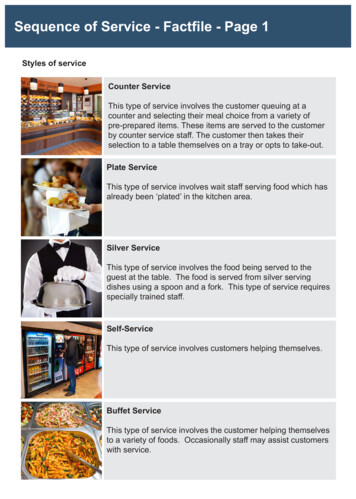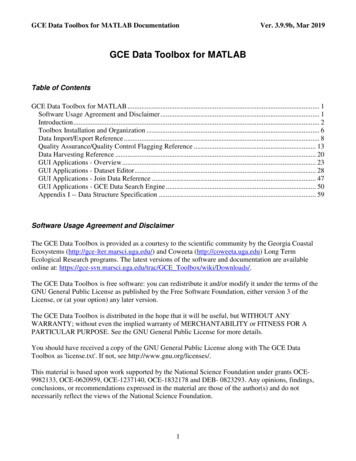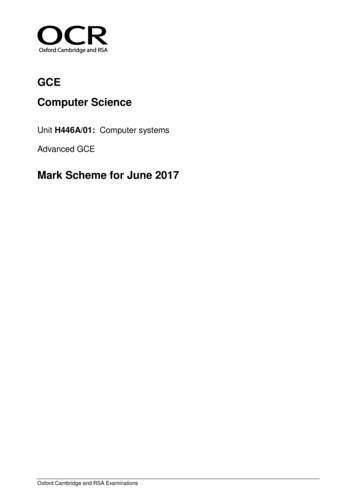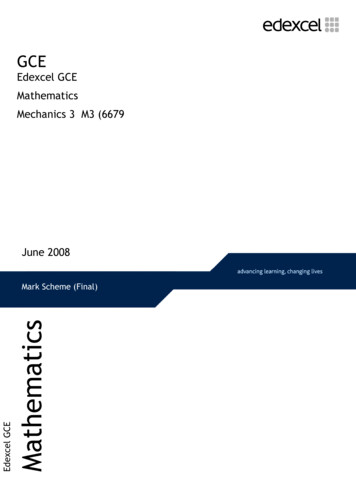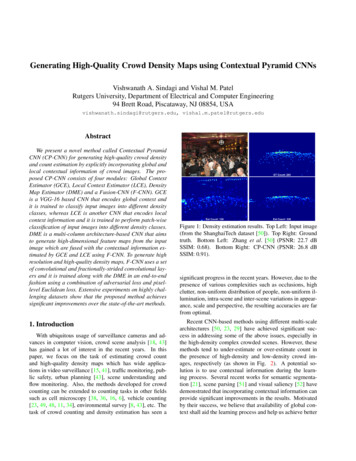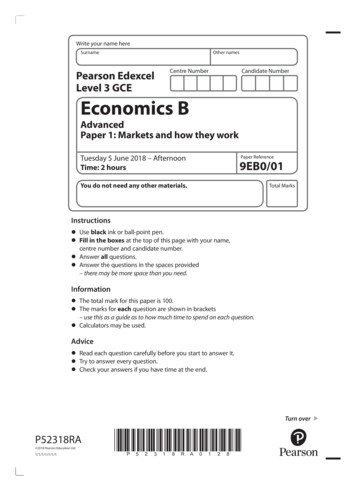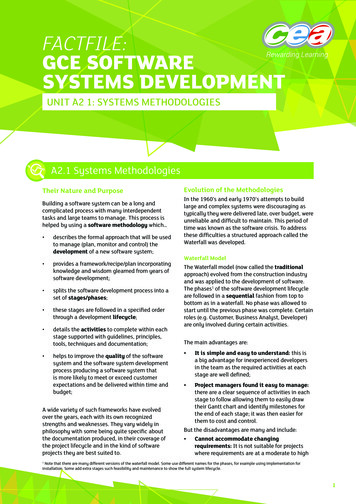
Transcription
FACTFILE:GCE SOFTWARESYSTEMS DEVELOPMENTUNIT A2 1: SYSTEMS METHODOLOGIESA2.1 Systems MethodologiesTheir Nature and PurposeBuilding a software system can be a long andcomplicated process with many interdependenttasks and large teams to manage. This process ishelped by using a software methodology which describes the formal approach that will be usedto manage (plan, monitor and control) thedevelopment of a new software system; provides a framework/recipe/plan incorporatingknowledge and wisdom gleamed from years ofsoftware development; splits the software development process into aset of stages/phases; these stages are followed in a specified orderthrough a development lifecycle; details the activities to complete within eachstage supported with guidelines, principles,tools, techniques and documentation; helps to improve the quality of the softwaresystem and the software system developmentprocess producing a software system thatis more likely to meet or exceed customerexpectations and be delivered within time andbudget;A wide variety of such frameworks have evolvedover the years, each with its own recognizedstrengths and weaknesses. They vary widely inphilosophy with some being quite specific aboutthe documentation produced, in their coverage ofthe project lifecycle and in the kind of softwareprojects they are best suited to.Evolution of the MethodologiesIn the 1960’s and early 1970’s attempts to buildlarge and complex systems were discouraging astypically they were delivered late, over budget, wereunreliable and difficult to maintain. This period oftime was known as the software crisis. To addressthese difficulties a structured approach called theWaterfall was developed.Waterfall ModelThe Waterfall model (now called the traditionalapproach) evolved from the construction industryand was applied to the development of software.The phases1 of the software development lifecycleare followed in a sequential fashion from top tobottom as in a waterfall. No phase was allowed tostart until the previous phase was complete. Certainroles (e.g. Customer, Business Analyst, Developer)are only involved during certain activities.The main advantages are: It is simple and easy to understand: this isa big advantage for inexperienced developersin the team as the required activities at eachstage are well defined; Project managers found it easy to manage:there are a clear sequence of activities in eachstage to follow allowing them to easily drawtheir Gantt chart and identify milestones forthe end of each stage; it was then easier forthem to cost and control.But the disadvantages are many and include: Cannot accommodate changingrequirements: It is not suitable for projectswhere requirements are at a moderate to highNote that there are many different versions of the waterfall model. Some use different names for the phases, for example using implementation forinstallation. Some add extra stages such feasibility and maintenance to show the full system lifecycle.11
FACTFILE: GCE SOFTWARE SYSTEMS DEVELOPMENT / SYSTEMS METHODOLOGIESrisk of changing and where they are incompleteor vague. This model is used only when therequirements are very well known, clearand fixed which is more likely in small shortprojects. It is not good for long and ongoingprojects or complex and object-orientedprojects. Forward direction of flow only: Can onlygo forward through the phases so there is nofeedback to guide previous phases. Project management is very authoritarian instyle: this does not help support the creativityof developers or use their skills in the best way. Testing performed at end of lifecycle: thisoften leads to errors discovered later in thelifecycle which may involve new design andcost more to change at this stage than if theywere discovered at an earlier stage. Less up-front planning: Prototyping is usedin place of detailed planning and this helps asoften a customer finds it difficult to expresstheir needs/requirements unless they canactually see a working model of the system. Shortens the lifecycle and enablingrapid delivery by speeding up design andimplementation. It does this by using specialtechniques and tools such as:Limited customer involvement: Customersare only involved in the early stages to definerequirements and at the end to test thefinished product which increases the risk thatthe product may not meet the customer’sneeds. Working software is delivered late in thelifecycle: Customers will not know whetherthe right product is being built and it is hard togauge progress.Integration is performed at end in a ‘BigBang’: which is risky as design problems mayonly be uncovered at a late stage which maycost a lot to fix.A new approach emerged in the 1990s in responseto these problems called Rapid ApplicationDevelopment.Several prototypes may be developed in parallelfor different parts of the system. RAD offers thefollowing advantages:2Computer-Aided Software Engineering(CASE) tools including code generatorswhich enable the automatic generation ofprograms and database code directly fromdesign documents, diagrams, forms, andreports. There is less manual coding.-Joint application design (JAD) sessions:Users, Managers and Analysts worktogether for several days in intensiveworkgroup sessions to specify or reviewsystem requirements.-Fourth generation/visual programminglanguages such as Visual Basic. The construction can be broken down intoseveral compartments/modules for whichseparate prototypes can be developed inparallel. Prototypes facilitate customer requirementsdetermination as they can visually see partof the working system which is good if thesystem is covering a new unfamiliar area of thebusiness where the customer finds it hard toexpress their requirements in a written form. Changing requirements can be easilyaccommodated in the evolving prototypes andthe solution is more likely to meet the needsof the customer as problems can be discoveredearlier in the process. Rapid delivery to the customer with highlevels of customer involvement during thecomplete development cycle reduces the riskof not meeting the customer’s requirements.Some business environments are so rapidlychanging that by the time the solution isdelivered it could be out of date already. Highcustomer involvement also encourages theacceptance of the new system as they are morefamiliar with it. Progress can be easily seen through theRapid Application Development (RAD)RAD2 compresses several steps of the waterfallprocess into an iterative process using prototyping3with high user participation. The developmentteam delivers a series of fully functional prototypesto the users who evaluate the prototype requestingchanges/further refinement. The developers reworkthe prototype and the process continues in a cycleuntil the software product evolves into the finalworking product satisfying the customers.-The James Martin version of the lifecycle includes four phases called requirements planning, user design, construction and cutover.The type of prototyping used in RAD is evolutionary as the model develops into the final system but there are many types of prototyping including throwaway in which the prototype is eventually discarded after use.32
FACTFILE: GCE SOFTWARE SYSTEMS DEVELOPMENT / SYSTEMS METHODOLOGIESproduction of working prototypes not just atthe end of the lifecycle, as in the waterfallmodel. This reassures the customer. There is no big bang integration at end.There is continuous integration of code.This reduces the risk of finding out that thearchitectural design is wrong at the end ofthe project. The design can be restructured atan early stage if necessary when the cost ofchange is less.But the disadvantages include: Less management control: Managing largerprojects is very difficult due to lack of planning. Demands more frequent user interactionthroughout project lifecycle and key businesspeople may find it difficult to make thatcommitment as their time is valuable to thebusiness. Requires highly skilled developers anddesigners: they must have wide experienceand a large skill set to rapidly respond andadapt the prototype to customer feedback – notime for training courses!processes and tools Working software overcomprehensive documentation Customercollaboration over contract negotiationResponding to a change, over following aplanThat is, while there is value in the itemson the right, we value the items on the leftmore.This manifesto emphasised the difference betweenagile and traditional methodologies such as theWaterfall model. Agile methodologies are stronglyinfluenced by RAD and prototyping but are moreclearly defined with their own tools and techniques.They can be used for Object Orientated softwaredevelopment projects.Agile methodologies follow the SoftwareDevelopment lifecycle phases of Analysis, Design,Implementation, Testing and Installation found inthe Waterfall model but these are performed in aniterative and incremental manner. Cost of CASE tools for modelling andautomated code generation is high making itless suitable for cheaper projects. Poor design: the focus on visual prototypesmay result in poor architectural design. Theremay also be problems with programmingstandards, documentation and maintenance. Lack of scalability. RAD typically focuses onsmall to medium-sized project teams.RAD is popular for web and e-commerce systemswhich are developed in rapidly changing businessenvironments.Agile MethodologiesAgile methodologies were formally introduced in2001 when the Agile Manifesto was published.The Agile ManifestoWe are uncovering better ways ofdeveloping software by doing it and helpingothers to do it. Through this work we havecome to value:Individuals and interactions over Incremental means that the system isbroken down into several smaller parts calledincrements. Each of these increments worksthrough the software development lifecycleand will be released to the customer as aworking subset of the system, frequently.-These frequent incremental releases allowthe customer to use part of the system atan early stage of development. This allowschanges to be suggested and progress tobe monitored throughout developmentreducing the uncertainty and risk of nondelivery. Requirements are implemented ina prioritised fashion enabling the highestbusiness value to be delivered first and todeliver on time.-This is in contrast to the waterfall whichdelivers the whole system at the endat once when change is difficult andexpensive.Iterative means that within each developmentphase of an increment there is an iterativecycle. This starts with a vague understanding ofthe system but as the development progressesthis understanding evolves and becomesclearer. So for example we might start with aset of very high level requirements which arequite broad and general. We then produceprototypes (performing analysis, design, code3
FACTFILE: GCE SOFTWARE SYSTEMS DEVELOPMENT / SYSTEMS METHODOLOGIESand testing) for the customer to evaluateand using their feedback we can produce amore refined prototype as we have a moredetailed and clearer understanding of theirrequirements.-These iterative cycles enable agile projectsto respond to rapidly changing customerrequirements as there are frequentopportunities for early feedback.It may be more difficult to estimate how longeach stage will take when the system is in theearly stages of development so planning ismore difficult, especially in large projects,but outline plans will evolve and change as thesystem develops.-In contrast the waterfall model requiresthat requirements are defined up frontearly in the project – they assume thatwe have all the necessary information tocreate detailed plans. This may be difficultin certain types of project which use noveltechnologies or for new business areaswith uncertain requirements and where thecustomer has little understanding of theirneeds without further exploration.-Within each iteration entire features aredeveloped and analysis, design, code and testare ALL performed. These iterations are performedin timeboxes in DSDM, sprints in XP and simplyiterations in XP.- Documentation is minimal and evolves(documents may be said to be ‘living’). Projectteams spend more time on development andless on documentation. This is especiallynoticeable in the XP agile methodology.In contrast in the waterfall model thedocumentation is extensive and heavyweight. Continuous customer/business involvementfrom an early stage helps to rapidly andflexibly respond to changing and evolvingrequirements increasing satisfaction andquality. In contrast the Waterfall model onlyinvolves the user at the beginning and endof the project which means they have littleopportunity to change the development of thesystem; this does mean that scope creep isminimised but the product may not be whatthe customer and the business really needs. Teams are encouraged to be self-directing,pro-active taking initiatives, be co-operativeand collaborative, self-organising andcross-functional. Project managers shouldbe respectful, facilitative, supportive andempowering. Teams will then be moremotivated and produce better results. Thisis particularly seen in the SCRUM stand upmeeting where members of the solution team(there are no designated roles) choose tasks tocomplete based on their own particular skillsand the SCRUM Master simply facilitates thisprocess. In contrast in the Waterfall modelthe Project Manager will delegate tasks to theprogrammer in an authoritarian manner. Face-to-face communication is encouraged:through the use of stand-up meetings andThe project is broken down into several parts atdifferent levels.A project is broken down into increments(also called releases).-Each increment is broken down intoiterations (also called timeboxes or sprintsdepending on the methodology).-Each iteration is broken down into tasks.At each level of breakdown there is feedback in aniterative cycle for example:-at the end of each increment/release thereis feedback from the customer who usespart of the system in a live environment- which helps to plan work for the nextincrement.-at the end of each iteration there is a reviewof the work (sprint review and retrospectivein SCRUM) which helps to plan the work inthe next iteration.testing is performed throughout theproject in contrast to the Waterfall modelwhen it is only performed at the end of thelifecycle where defects are more difficultand costly to resolve.Other differences between agile and traditionalmethodologies include:Agile methodologies are both incremental ANDiterative.-at the end of a daily task there is a standup meeting where feedback is given whichsteers the work for the next day.4
FACTFILE: GCE SOFTWARE SYSTEMS DEVELOPMENT / SYSTEMS METHODOLOGIESfacilitated workshops the whole team isencouraged to use face-to-face communicationinstead of documentation as it is more efficientand misunderstandings can be quicklyaddressed. Developers communicate directlywith the customer (who may be collocated on-site) who play an important role in offeringestimates of work effort for each requirementso informed decisions on what can workedon next can be made quickly. In the waterfallapproach the developers and customers arecompletely separated and the communicationis largely through documentation created bythe Analyst; this is less responsive, slow, andopen to misinterpretation. Continuous Integration: as the productevolves incrementally the code is continuouslyintegration rather than at the end in one ‘BigBang’.A Comparison of Three AgileMethodologiesThe agile methodologies called DSDM4 , SCRUM, andXP implement the agile philosophies and principlesbut have a different focus (DSDM: project, businessvalue; SCRUM: team, empirical; XP: engineering,technical). Here we compare and contrast thesemethodologies by reference to stages withintheir lifecycles and their tools and techniques.Sources for lifecycle diagrams are suggested in theresources section of this document.Project Management As observed from its lifecycle diagramDSDM is the only methodology of the three that coversthe project lifecycle fully from start to finish.5 It details what should be contained in a number ofproject level documents6 for example: In the PRE-PROJECT phase the Terms of Reference (with objectives, tentative timescale,available funding and outline of scope) is created. In the FEASIBILITY stage the Feasibility Assessment is conducted to determine if the project isviable. Throwaway prototyping may be used to understand possible solutions. In the FOUNDATION stage several outline documents are created including the:- Business Case: containing business benefits and outline costs.- Management Approach: with project management activities like risk, communication,quality, change, and configuration management.- Solution Architecture Definition: describing for example the computer hardware andnetwork, security and control.- Development Approach: for example coding standards and styles, testing strategies. In the POST PROJECT stage there is a Project Review document which measures the benefits ofthe new project, after a settling in period of say 6-12 months, and compares to those expectedfrom the business case.Note also: SCRUM can simply be slotted into DSDM, being wrapped in its extra project level activities ifdesired. In XP a lot of up-front detailed planning is considered unnecessary and there practically nodocumentation. The stories themselves are held to represent the scope which is agreed by thecustomer. The design is said to be visible within the structure of the code itself.DSDM was published in 1995 and evolved into DSDM Atern in 2007 and into DSDM Agile Project Framework in 2014.The whole software development project can be considered as a timebox with a start and end date. XP does have a maintenance and death phase.6These are living documents which evolve through the lifecycle which are only outlined at this stage; just provide the minimum information required.Students will not be expected to know the specific names of these documents but should have an appreciation of their overall content so they know whathappens in this stage of the lifecycle.455
FACTFILE: GCE SOFTWARE SYSTEMS DEVELOPMENT / SYSTEMS METHODOLOGIESRoles & Teams InDSDM there are twelve roles from business, project management and technical backgrounds.Eight are further described below: Business Sponsor: responsible for providing the funds and resources; gives the go-ahead toinitiate the project and to move through the feasibility and foundation stages by approving theTerms of Reference, Business Case and Management Foundations documents; not involved in theday-to-day details. Business Visionary: helps define the high level requirements in the foundations phase makingsure they meet the needs of the business; communicates with stakeholders; approves thePrioritised Requirements List. Business Ambassador: representative of business that will use solution who helps to explore therequirements further during timeboxed development; day-to-day input. Project Manager: coordinates the project as a whole; leaves the detailed planning within atimebox to the team; produces the Management Foundations document and Delivery Plan. Team Leader: co-ordinates the work of the solution development team and ensures theincrements are delivered on time. Business Analyst: link between business and solution development team; responsible forproducing the Business Case and Prioritised Requirements List document. Solution Developer: develops prototypes and codes solution to be deployed. Solution Tester: designs and executes tests, recording results.In contrastSCRUM is simpler having only three roles: Product Owner: A representative from the business. They help define, prioritise and groom theproduct backlog to meet their vision for the new system. Scrum Master: Guides/facilitates/coaches the team in following the SCRUM methodology helpingto remove any obstacles that might slow progress. This is not a traditional project managementrole as he has no authority to exert control over the team; Development Team: A collection of people who design, build and test, typically 5-9 in size. Thereare no specific designated roles such as programmer, tester, and database administrator as intraditional projects. Teams self-organise selecting tasks which suit their skills in the daily SCRUM.In XP there are many roles; four main roles are briefly outlined below: On-site Customer: they write user stories and acceptance tests, set priorities and must always beavailable to answer questions. This requires a big commitment from the business as the customermust be permanently on-site. Programmer: estimates the effort/cost of each story; breaks stories into tasks; designs unit testsand then codes. Coach: makes sure the project stays on track; trains team members. Tracker: monitors programmers taking action if anything goes off track.Note: People can sometimes play more than one role. The Business Sponsor Business Visionary Business Ambassador in DSDM have similarresponsibilities to the Product Owner in SCRUM and the Customer in XP. 7 The Team Leader in DSDM is broadly equivalent to the Scrum Master in SCRUM and the Coach Tracker in XP.7 DSDM having a broader range of business representatives has an advantage in that there is less pressure on one person and they will have a broaderknowledge at all levels of the business, although the Product Owner and Customer do consult with all the stakeholders (end-users, operational staff,management, etc). Students should have an appreciation of the difference in the spread of roles available in each methodology – it is good to identifyfrom the case study key business people who can play the role of the customer (or similar role).6
FACTFILE: GCE SOFTWARE SYSTEMS DEVELOPMENT / SYSTEMS METHODOLOGIESRequirements Gathering & SpecificationAll the agile methodologies begin by capturing the requirements at a very high level which areelaborated later. In DSDM the gathering of high level requirements begins in the Foundations Phase. They aredetailed in the Prioritised Requirements List.SCRUM the requirements are contained in the Product Backlog; the format is not specified,but they are often stories. In XP the requirements are captured as stories8 in the Exploration phase with the Customer. InPrioritisation of RequirementsRequirements in agile projects are continually prioritised according to business value with a businessrepresentative. In DSDM the requirements are prioritised using the MoSCoW method in the foundations phaseand throughout evolutionary development as the requirements become more detailed and refined.The mnemonic simply means:M – Must have requirementsS – Should have if at all possibleC – Could have but not criticalW – Won ‘t have this time, but potentially later InSCRUM the product owner has the responsibility, in consultation with other stakeholders, ofcontinually prioritising items in the Product Backlog9, ordering them from their highest to lowestbusiness value. In XP the customers place the stories in order of priority, possibly as sticky notes on a whiteboard,in the Planning phase.Planning Delivery to the Customer (Release/Deploy/Ship) In8910 DSDM an outline of the planned releases are specified in the Release Plan in theFoundations Phase. This gives an outline of the releases which are deployed10 to the customerin a series of increments. Each release will contain one or more development timeboxes to whichprioritised requirements are allocated. This is followed by a deployment timebox. At the end of eachincremental deployment there is an opportunity for the customer to give feedback (shown by backarrows on the lifecycle) into the planning process.A story is a simple description of a product requirement which may be written on an index card. It is written in the customer’s own language avoidingany technical jargon. It might also describe bugs to be fixed and non- functional requirements.This is said to be ‘living’.Deployment is the physical act of putting what has been assembled (the release) out into operational use. Several incremental solutions resultingfrom the timebox development in the previous phase are assembled into a single release, reviewed/checked as a whole, and deployed (put into thelive business environment). It also includes such things as performing changeover, training users, setting up data and providing documentation andsupport to end-users.7
FACTFILE: GCE SOFTWARE SYSTEMS DEVELOPMENT / SYSTEMS METHODOLOGIES InSCRUM a release plan is not specifically shown on the lifecycle as each developmental sprintcreates a ‘potentially shippable product’ which can be shipped right away or held back andgrouped with other sprints depending on what the product owner wants.11 A subset of the items inthe product backlog that can be fitted into a sprint are selected from the top of the product backlogfor sprint planning. In XP the focus is on continuous small releases to the customer at frequent intervals. Thesereleases are planned in the Planning Phase12 (or game). The developer estimates the cost/effort foreach story depending on the difficulty of the story. The customer agrees on which ones to includein a release based on business value. The release plan may simply be a set of user stories on stickynotes stuck on a whiteboard and organised into releases, ordered by priority. Stories from the releaseare selected for the forthcoming iteration.Planning the Work in the Time WindowThe requirements/features selected for the timebox/iteration/sprint are often broken into simplerdevelopment tasks. The duration of each task is estimated to confirm everything can be fitted in thetimebox/sprint/iteration. In In DSDM the timebox should have a mix of Must haves, Should haves and Could haves.SCRUM the subset of items from the product back log selected for development is called thesprint backlog. Sprints last about 30 days. In XP this breakdown into tasks takes place in the Planning phase. Iterations last 1-3 weeks.Executing the Work in the Time WindowEach day the solution development team/programmers select tasks to complete each day ensuring theywork at a sustainable pace. The execution involves many elements of the software development lifecycleincluding the analysis, design, code and test of features in a daily iterative cycle.The cycle begins with the daily stand up, also called the SCRUM. In this meeting (15 minutes long,same place, same time) everyone stands up to help keep the discussion short. They ask three things:What have I done? What am I going to do? What problems do I have? In DSDM the ability to leave out requirements based on MoSCoW prioritisation, reducing scope,helps to ensure that the project keeps on time and to budget. The execution is said to be completed inSCRUM when it is ‘done’ in other words when there is apotentially shippable product increment. This definition of ‘done’ usually means that features haveat a minimum been designed, built, tested and documented but the definition of ‘done’ could bemore stringent if the customer desires; XP goes further and says the work is complete when until the code passes customer acceptancetests.1112Release planning could be performed by simply grouping the items in the product backlog into releases.Planning in XP may be separated into release and iteration planning in the planning game.8
FACTFILE: GCE SOFTWARE SYSTEMS DEVELOPMENT / SYSTEMS METHODOLOGIESNote: XP is a methodology that is specific for software projects (unlike SCRUM and DSDM that can beused for any type of project). It specifies 12 practices some of which are specifically related tosoftware engineering and are often adopted by other methodologies: Pair Programming13 [twoprogrammers, one task, one workstation]; Planning Game [planning meeting for releases anditerations once per iteration]; Test-Driven Development [unit tests written before coding]; WholeTeam [customer uses system and co-located with software development team]; ContinuousIntegration [always work on latest version; upload code every few hours]; Refactoring [makearchitecture simpler and improve design]; Small Releases [frequent releases of live functionality];Coding Standards [consistent style and format for source code]; Collective Code Ownership[everyone jointly responsible for code]; Simple Design [refactor when possible to make codesimpler]; System Metaphor [story describing how system works]; Sustainable Pace [softwaredevelopers should not work more than 40 hours a week] . Burndown charts are used to monitor/track progress showing how much work is left to do againsttime.Review of the Work in the Time WindowAt the end of a timebox/iteration/sprint the working product is demonstrated to the BusinessRepresentative who inspects it to see if the requirements have been fulfilled. InSCRUM there are two specific reviews: Sprint Review: In this review meeting the PRODUCT/SYSTEM is reviewed checking what has beendone/not done. Everyone attends this meeting. Sprint Retrospective: in this review the PROCESS that created the product/system is reviewed. Thesoftware development team including the Scrum Master attends this meeting.13One is driver in control of the keyboard and mouse; the other is the navigator who watches the driver implementing, identifies defects and gives ideas;swap over. Benefits: higher quality code, faster, more enjoyable, more confidence in work.9
FACTFILE: GCE SOFTWARE SYSTEMS DEVELOPMENT / SYSTEMS METHODOLOGIESApplying MethodologiesWhen considering which methodology to apply weshould consider: proposed system complexity (routine cookiecutter solutions do not apply) and size; need for reliability/safety/security; importance of schedule visibility; project timescales; required documentation (e.g. in a highlyregulated industry). skills of the Software Development Team (canthey cope with evolv
Agile methodologies follow the Software Development lifecycle phases of Analysis, Design, Implementation, Testing and Installation found in the Waterfall model but these are performed in an iterative and incremental manner. Incremental means that the system is broken down into several smaller parts called increments. Each of these .

